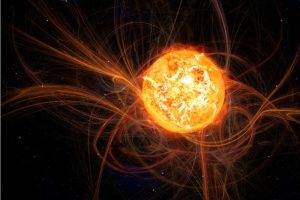Do stars move?
30th Nov 2022
Every time we look at the starry sky, it seems majestically still. Of course, there is an apparent daily motion of the stars associated with the Earth’s rotation, but it does not change their relative position to each other. That is, the constellations that we studied in astronomy lessons in childhood still seem the same to us today. So do stars move or are they stationary? Let’s find out.
Do stars move or do we move?
Both. We are used to saying that the Sun rises in the East and sets in the West, but we know for sure that it is not the Sun that revolves around the Earth, but the Earth, together with other planets of the solar system, revolves around the Sun. However, the Sun also does not stand still. It moves in its orbit in our Milky Way galaxy. And since the Sun is a star, the answer to the do stars move question becomes obvious. Billions of stars in different galaxies are moving in their orbits and rapidly, traversing billions of kilometres annually. Then why do they seem motionless when we look at them? It’s all about distance.
Imagine that an object is one kilometre away from you and is only moving by a millimetre — you will not notice this movement. The stars closest to us are so far away that very precise astronomical instruments, and measurements are needed to notice the stars moving in the sky. Sometimes it takes months or even years to see it. Our closest star, Proxima Centauri, is about four light years, or about 37 million kilometres, away. And most of the stars visible to the naked eye are several hundred light-years away from us. Compare that distance with that of our Sun, which is only eight light-minutes away!
How fast do stars move?
Too fast by earthly standards. A branch of astronomy, stellar kinematics, deals with the study of Stars shifting in the Universe. With different telescope types at their disposal, scientists determined that plenty of stars move at a speed of about 60 miles per second. But there are also the so-called ultra-fast stars that move many times faster. They include:
- Halo stars typically move in elliptical orbits outside the plane of the Milky Way at speeds up to 150 miles per second (mps).
- runaway stars leaving our galaxy as a result of a supernova explosion or a close approach of two double stars and their destruction into smaller ones;
- hypervelocity stars closer to the galactic centre. Their speed can reach 600 mps or more.
The fastest hypervelocity star to date, S4714, was discovered in 2020 by a research team led by astrophysicist Florian Peisker of the University of Cologne using the Very Large Telescope (VLT) located in the Chilean desert. S4714 orbits the supermassive black hole Sgr A* at the centre of our galaxy at over 8% the speed of light, or 15,000 miles per second. This high speed, according to scientists, is explained by the powerful gravitational impulse created by the black hole.
How fast do shooting stars move?
Sometimes, we see a bright streak of light in the night sky, which we call a shooting star. However, this phenomenon has nothing to do with real stars. This is a meteor, a fragment of a comet or an asteroid that falls into our planet’s gravitational field and alights as it makes contact with the dense layers of the Earth’s atmosphere. But it flies fast enough — from 6 to 40 mps. That is why we see a bright trail, which we metaphorically perceive as the light of a falling star.
Do stars move away from each other?
Yes and no. At the beginning of the 20th century, astronomer Edwin Hubble, the one after whom the Hubble telescope is named, was one of the first to conclude that the Universe consists of many galaxies inhabited by billions of stars. His subsequent research led to his most famous discovery: that galaxies are moving away from each other at a rate proportional to their distance. That is, the further the galaxies are located from each other, the faster they move away. Thus, Hubble’s Law was formulated, which proved that the Universe is expanding.
Nevertheless, galaxies still have random velocities of their own motions — from several hundred to several thousand km/s. For this reason, if they are relatively close together, the velocities of random motions make Hubble’s Law inapplicable; such galaxies can either move away or approach and even collide. By the way, the latter is considered the normal evolution of galaxies, and contributes to their rejuvenation. Their collisions also occur differently depending on the speeds and shapes of galaxies (spiral, elliptical, and irregular). They can cling to each other, pass through, merge like drops of water, or even collide frontally.
Scientists suggest that in about 3 billion years, our Milky Way Galaxy will come close to a larger one — the Andromeda Nebula. One can only guess what will happen as a result since the approach speed is 300 km/s. But perhaps they will merge and give life to a new star system. In any case, this will happen by the time our Sun has turned into a dying star and the Earth is uninhabitable.
Do stars move around the Earth?
Certainly not. The Earth is too small to be the centre of attraction for the stars, and the planet itself revolves around the star, the Sun. But why do stars appear to change position in the sky during the night?
Indeed, while observing the starry sky for several hours on a clear night, one can notice that the firmament, as a whole, smoothly rotates around some imaginary axis passing through the place of observation. This rotation of the stars in the sky is called diurnal motion since one complete revolution takes place in one day. Due to our planet’s daily rotation, the stars constantly change their position relative to the sides of the horizon.
In what direction do the stars appear to move?
The stars travel from East to West. As soon as dusk sets, the first stars appear to pass through the eastern part of the sky to disappear at dawn in its western part. Why do stars appear to move from East to West? Due to the rotation of the Earth around its axis, it seems that they, like the Sun, rise and set.
How do constellations move
Just like all other stars. In fact, constellations are simply groups of the brightest stars that people have tied into separate shapes, similar to objects, mythological characters, and animals, so that they are easier to remember and navigate in the starry sky. In total, there are 88 officially recognized constellations, the most famous of which are the twelve zodiacs, the constellation of Ophiuchus, Ursa Major and Minor, Cassiopeia, etc.
The pattern of the constellations is also changing, though very, very slowly. Tens of thousands of years ago, the Big Dipper looked completely different, and our descendants, who will live in a hundred thousand years, will no longer see the dipper we are used to, but rather a frying pan with a long handle.
Conclusion
Astronomy and space investigation have given us a clear understanding that space is inhabited by billions of stars, planets, and other objects. Our Earth, Sun, and Solar system are only a microscopic part of this vast world. Do stars move? Yes, just like everything in our Universe. But we don’t see the star shifting due to gigantic distance scales. After all, even the light of distant stars needs millions of years to reach us. In other words, when we look into space, we look into the past. And if a highly developed civilization is watching us in one of the distant galaxies, it may now see dinosaurs roaming the surface of our planet.
![Beauty of the Pink Moon And Lyrid Meteor Shower in This Week’s Best Astrophotos [19-26 April] Beauty of the Pink Moon And Lyrid Meteor Shower in This Week’s Best Astrophotos [19-26 April]](https://orbitaltoday.com/wp-content/uploads/2024/04/Pink-Moon-is-on-its-way-above-the-mountains-1-300x300.jpg)





Thank you for your comment! It will be visible on the site after moderation.